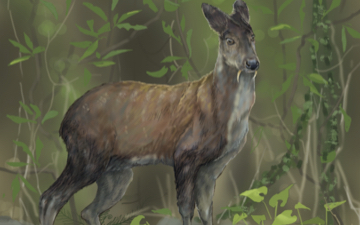Musk deer can refer to any one, or all seven, of the species that make up Moschus, the only extant genus of the family Moschidae.[1] Despite being commonly called deer, they are not true deer belonging to the family Cervidae. The musk deer family differs from cervids, or true deer, by lacking antlers and facial glands and by possessing only a single pair of teats, a gallbladder [2], a caudal gland, a pair of tusk-like teeth and—of particular economic importance to humans—a musk gland.
Musk deer live mainly in forested and alpine scrub habitats in the mountains of southern Asia, notably the Himalayas. Moschids, the proper term when referring to this type of deer rather than one/multiple species of musk deer, are entirely Asian in their present distribution, being extinct in Europe where the earliest musk deer are known to have existed from Oligocene deposits.
Musk deer resemble small deer, with a stocky build and hind legs longer than their front legs. They are about 80 to 100 cm (31 to 39 in) long, 50 to 70 cm (20 to 28 in) high at the shoulder, and weigh between 7 and 17 kg (15 and 37 lb). The feet of musk deer are adapted for climbing in rough terrain. Like the Chinese water deer, a cervid, they have no antlers, but the males do have enlarged upper canines, forming sabre-like tusks. The dental formula is similar to that of true deer: 0.1.3.33.1.3.3
The musk gland is found only in adult males. It lies in a sac located between the genitals and the umbilicus, and its secretions are most likely used to attract mates.
Musk deer are herbivores, living in hilly, forested environments, generally far from human habitation. Like true deer, they eat mainly leaves, flowers, and grasses, with some mosses and lichens. They are solitary animals and maintain well-defined territories, which they scent mark with their caudal glands. Musk deer are generally shy, and either nocturnal or crepuscular.
Males leave their territories during the rutting season, and compete for mates, using their tusks as weapons. Female musk deer give birth to a single fawn after about 150–180 days. The newborn young are very small, and essentially motionless for the first month of their lives, a feature that helps them remain hidden from predators.[3]
Musk deer have been hunted for their scent glands, which are used in perfumes. The glands can fetch up to $45,000/kg on the black market. It is rumored that ancient royalty wore the scent of the musk deer and that it is an aphrodisiac.[4]
(From Wikipedia, June 2021)




